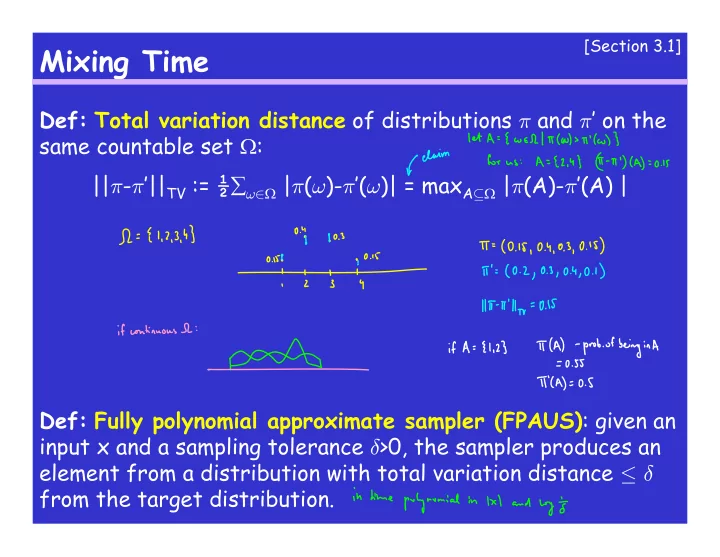

[Section 3.1] Mixing Time Def: Total variation distance of distributions π and π ’ on the same countable set : || π - π ’|| TV := ½ ω ∈ | π ( ω )- π ’( ω )| = max A ⊆ | π (A)- π ’(A) | Def: Fully polynomial approximate sampler (FPAUS) : given an input x and a sampling tolerance δ >0, the sampler produces an element from a distribution with total variation distance ≤ δ from the target distribution.
[Section 3.3] Detailed Balance and Reversibility Lemma 3.7: Let ( ,P) be a MC. If distribution π ’ on satisfies π ’(x)P(x,y) = π ’(y)P(y,x) for every x,y ∈ , then π ’ is a stationary distribution of the MC. Note: the condition from Lemma 3.7 is known as detailed balance (or time reversibility of the MC).
Symmetric MC and the Metropolis Filter What is the stationary distribution when the MC is symmetric (i.e. P(x,y)=P(y,x) for every x,y) ? Metropolis Filter : Suppose we want a stationary distribution π on and we have designed the transitions (but not their probabilities) so that the MC is ergodic. How to set up the transition probabilities ?
[Chapter 4] Mixing Time cont’ Def: Given an ergodic MC ( ,P) with stationary distribution π , its mixing time from a state x ∈ is: τ x ( ² ) := min{ t: ||P t (x,.)- π || TV ≤ ² }. Overall mixing time is τ ( ² ) := max x ∈ τ x ( ² ). Note: the definition makes sense, i.e., ||P t (x,.)- π || TV is a non-increasing function of t. [Lemma 4.2]
[Chapter 4] Coupling Recall the MC for colorings: • Choose a vertex v u.a.r. (uniformly at random) • Choose a color c u.a.r. • If none of v’s neighbors is colored by c, recolor v by c. • Otherwise, keep v’s original color. We’ll modify the MC to choose a color not used by any of v’s neighbors. Claim: Let q be the number of colors. If q ≥ M +2, where M is the maximum degree in the graph, then MC is ergodic.
[Chapter 4] Coupling MC for colorings: • Choose a vertex v u.a.r. (uniformly at random) • Choose a color c not used by any neighbor of v u.a.r. • Recolor v by c. Prop. 4.5: Let G be a graph with max.deg. M . Let the number of colors q ≥ 2 M +1. Then the MC mixes in time: τ ( ² ) ≤ qn/(q-2 M ) ln(n/ ² ).
[Chapter 4] Coupling Coupling idea: - Run two identical MC’s. - They can (and most likely will) be dependent but each without seeing the other MC follows the prescribed transition probabilities. - Start the first MC in the stationary distribution, the other MC starts anywhere. - Goal: the MC’s coalesce, thus the second MC is also following the stationary distribution. - Want to set up the dependence between the MC’s so that they agree with each other more and more as time progresses.
[Chapter 4] Coupling Coupling, formally: Given a MC ( ,P). A MC on x is a coupling for the above MC if it goes through states (X 0 ,Y 0 ),(X 1 ,Y 1 ),(X 2 ,Y 2 ),… such that: Pr[X i+1 =x’ | X i =x, Y i =y] = Pr[Y i+1 =y’ | X i -x, Y i =y] =
[Chapter 4] Coupling Warmup: MC on the n-dimensional hypercube (i.e., binary numbers of length n): - With probability ½ do not do anything. - Otherwise, choose a random position i and flip the i-th bit. Coupling:
[Chapter 4] Coupling Lemma 4.7 [Coupling Lemma]: Suppose we have a MC with transition matrix P. Let (X t , Y t ) be a coupling of this MC and suppose t:[0,1] N is a fnc such that Pr[X t( ² ) Y t( ² ) | X 0 =x, Y 0 =y] ≤ ² . Then, the mixing time of the MC: τ ( ² ) ≤ t( ² ).
[Chapter 4] Coupling Back to colorings – how to couple ?
[Chapter 4] Coupling Back to colorings – notation:
[Chapter 4] Coupling Back to colorings – notation:
[Chapter 4] Coupling Back to colorings – how to couple ? - What if the colors of v differ ?
[Chapter 4] Coupling Back to colorings – how to couple ? -What if the colors of v agree ?
[Chapter 4] Coupling Back to colorings – finishing the argument
Some useful inequalities Markov’s: If X is a non-negative random variable and a>0, then Pr(X>a) ≤ E(X)/a Chebyshev’s: For any a>0: Pr(|X-E(X)| ≥ a) ≤ Var(X)/a 2 No name: 1+x ≤ e x
[Chapter 4] Path Coupling - simplifies the coupling analysis Idea: - define distance between states - if neighboring states get closer in one step (in expectation), then all pairs of states get closer in one step - therefore, we have a coupling
[Chapter 4] Path Coupling Applied to colorings: - distance: - how to couple neighboring states:
[Chapter 4] Path Coupling Now in the math-language (drawing from Lemmas 4.14-6): Lemma: Suppose for every pair of adjacent states X 0 ,Y 0 : E[distance(X 1 ,Y 1 ) | X 0 ,Y 0 ] ≤ (1- α )distance(X 0 ,Y 0 ) Then, τ ( ² ) ≤ α -1 ln(maxdist/ ² ) where maxdist is the maximum distance between any two states.
Recommend
More recommend